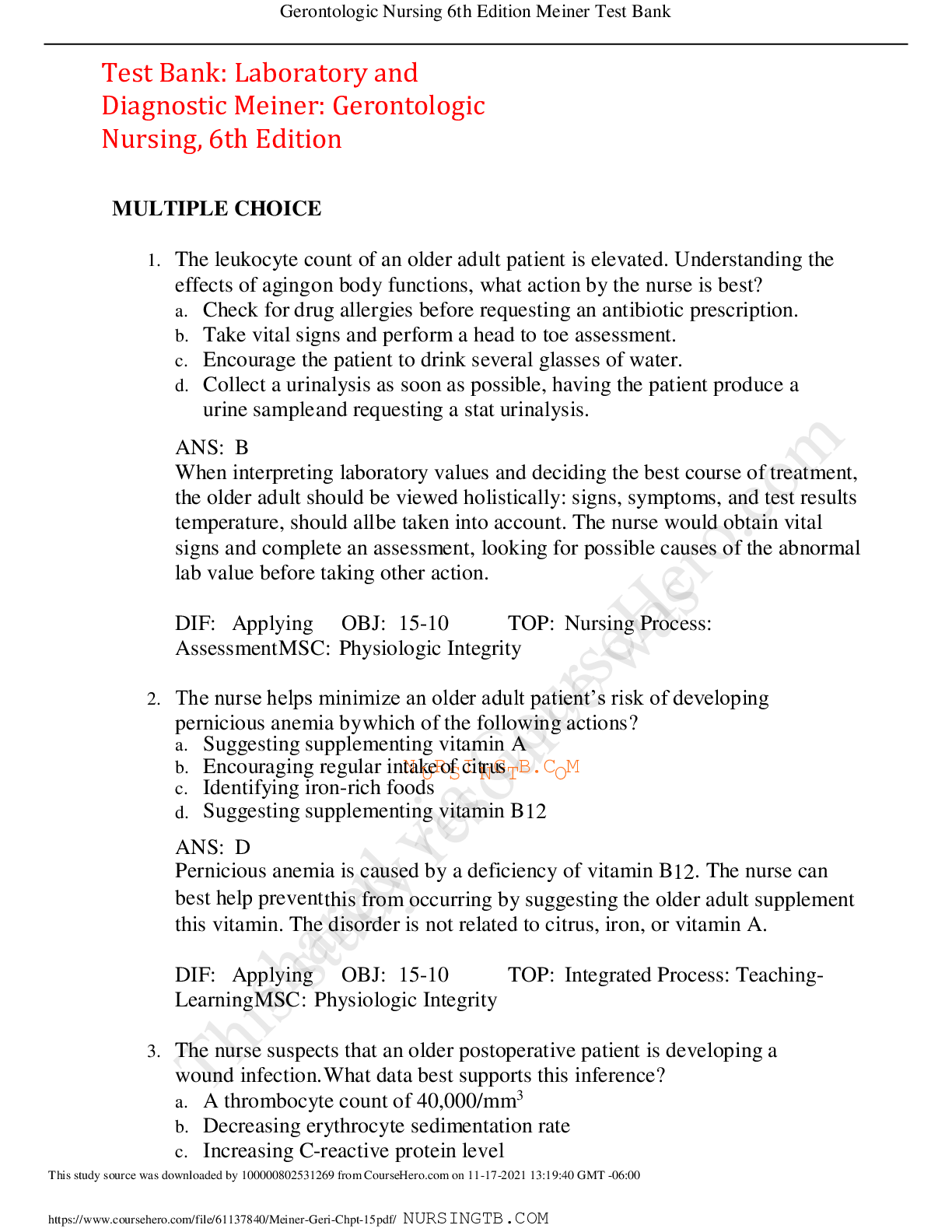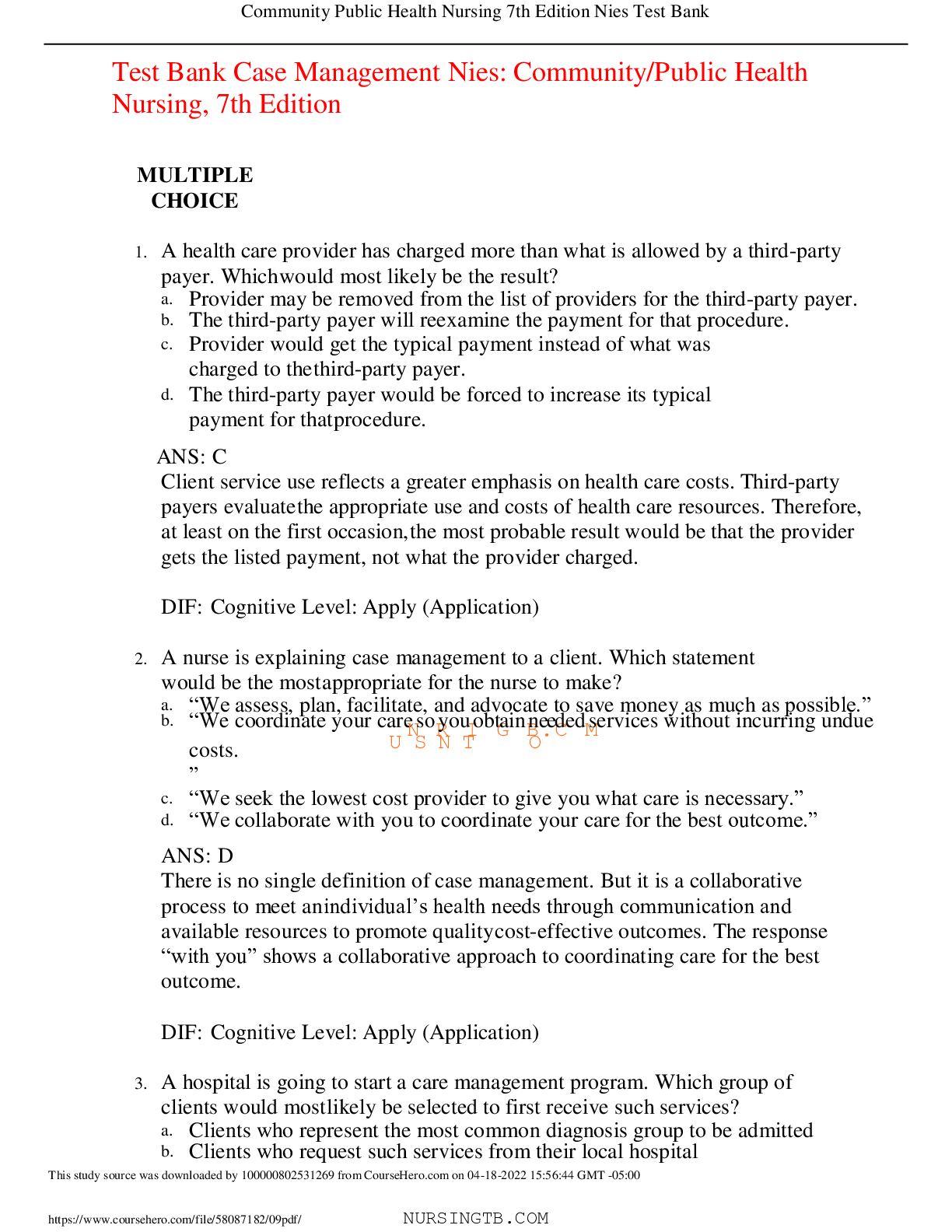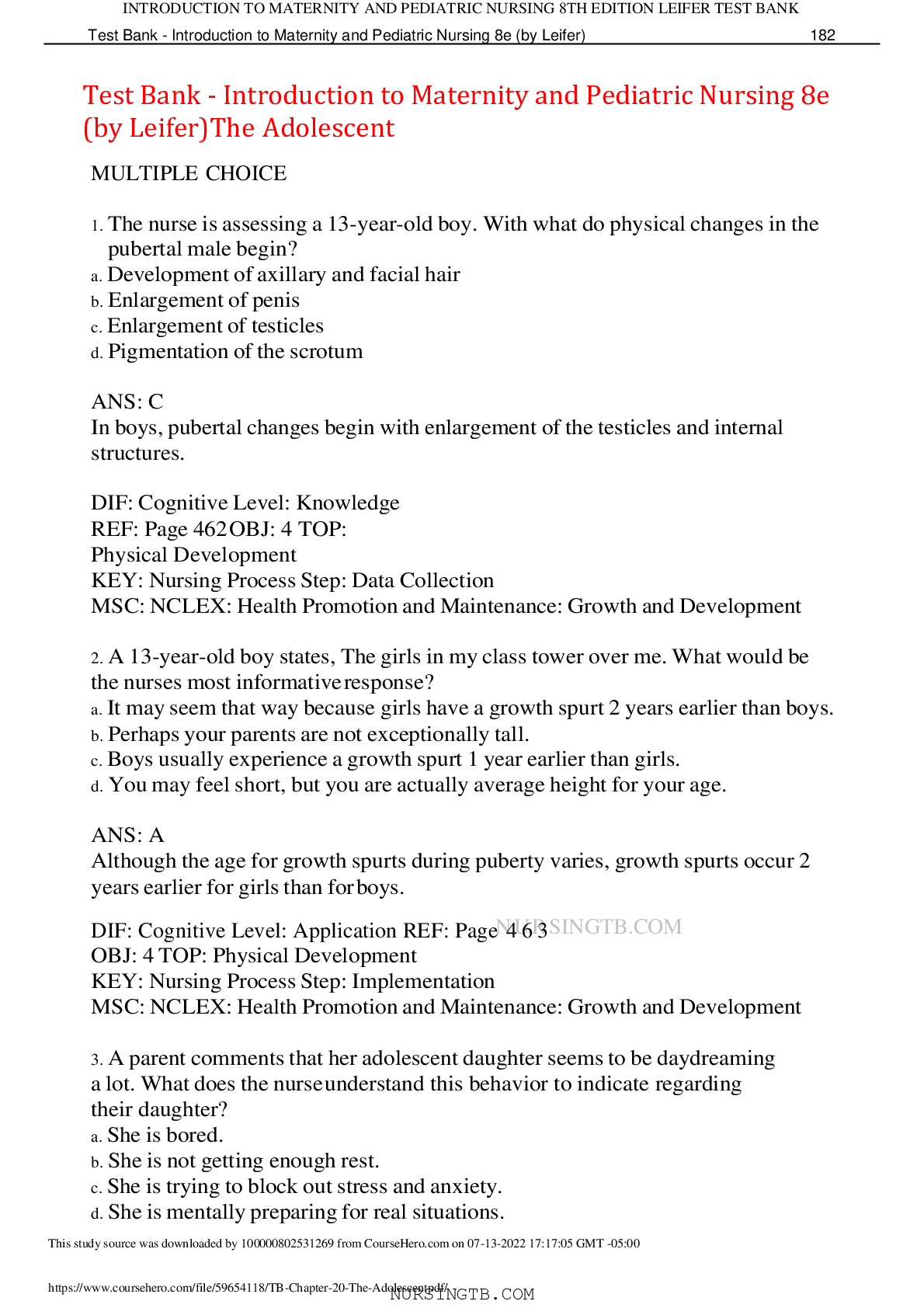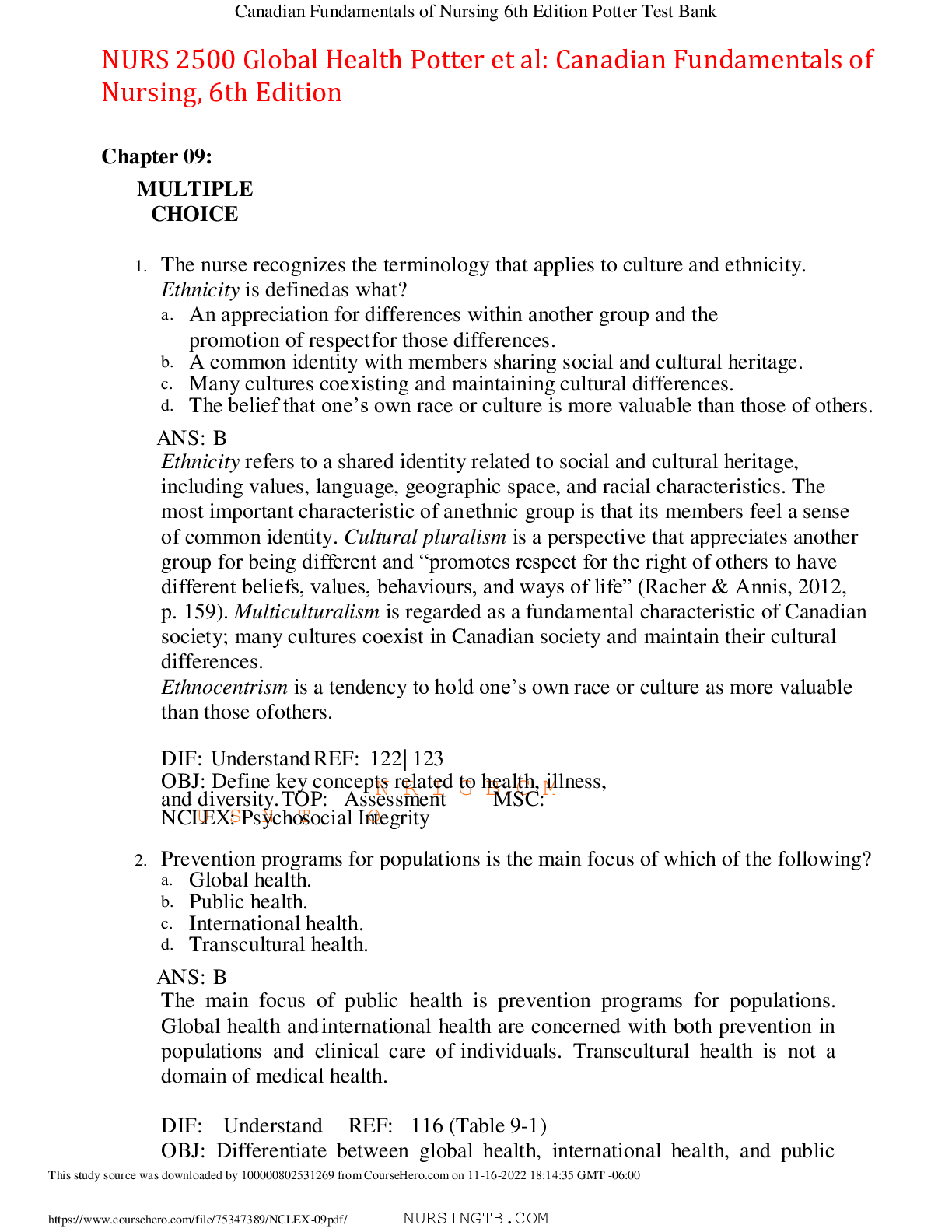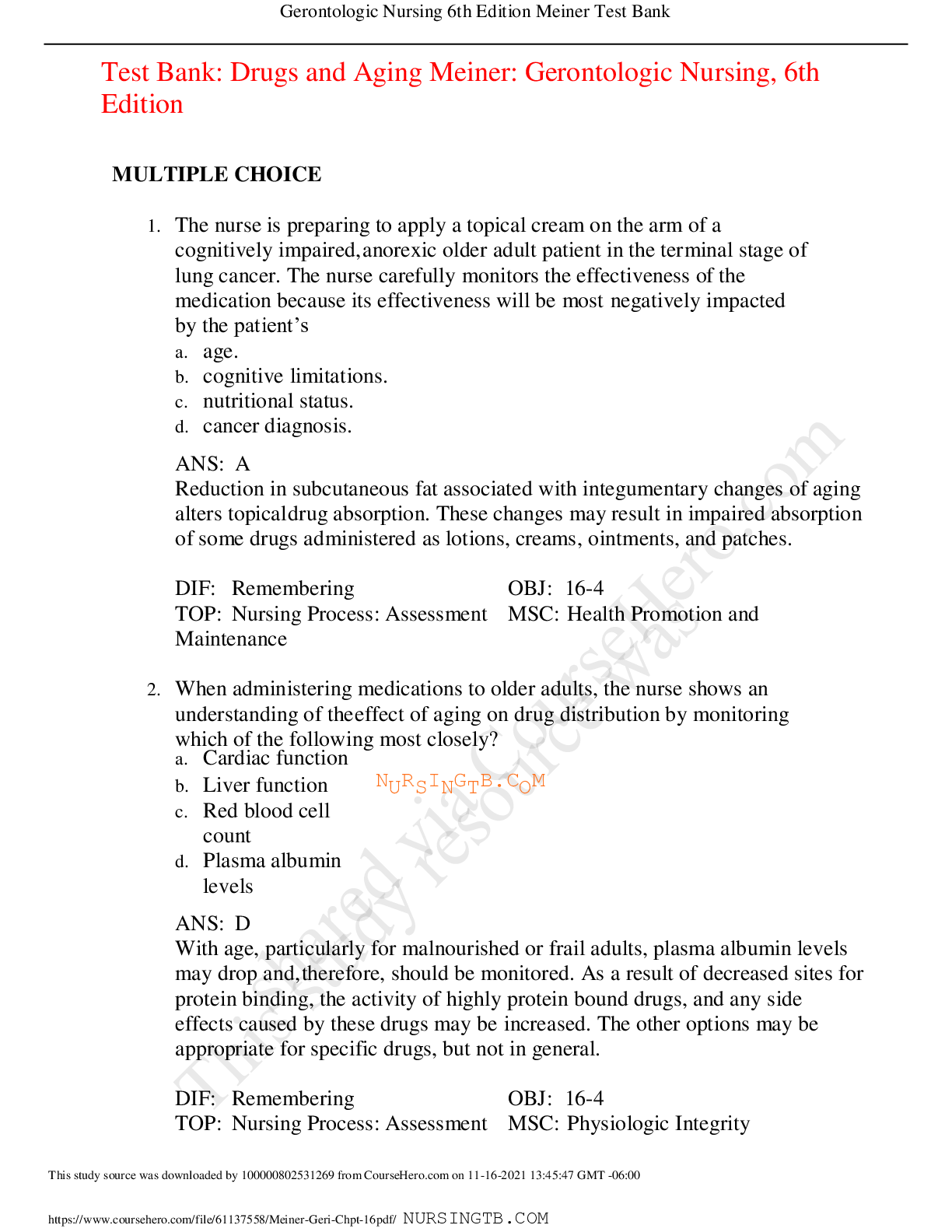*NURSING > TEST BANK > Test Bank: Sleep and Activity Meiner: Gerontologic Nursing, 6th Edition,100% CORRECT (All)
Test Bank: Sleep and Activity Meiner: Gerontologic Nursing, 6th Edition,100% CORRECT
Document Content and Description Below
Test Bank: Sleep and Activity Meiner: Gerontologic Nursing, 6th Edition Chapter 10: MULTIPLE CHOICE 1. A patient reports to the nurse that he seems to be sleeping less at night but now regularl... y requires at least two short naps a day. He expresses a concern that “something is wrong.” Which response by the nurse is best? a. “Aging alters our sleep patterns, so what you describe is really quite common.” b. “Circadian sleep rhythms are controlled by the hypothalamus, which is affected by age.” c. “Sleep patterns are affected by so many things; have you been under a lot of stress lately?” d. “Can you be more specific about what you think is wrong with your sleep pattern?” ANS: A The decrease in nighttime sleep and the increase in daytime napping that accompanies normal aging may result from changes in the circadian aspect of sleep regulation. While the second statement is correct, it is not how the nurse would explain sleep regulation and does not let the patient know his sleep patterns are normal at his age. Asking about stress also does not reassure the patient and is vague. Yes/no questions are not therapeutic. DIF: Understanding OBJ: 10-1 TOP: Integrated Process: Teaching-Learning MSC: Physiologic IntegritNyURSINGTB.COM 2. What is the best bedtime snack for older adult patients with insomnia? a. Ice cream in a waffle cone b. Bowl of grapes c. Glass of milk and a macaroon cookie d. Cup of cream of broccoli and cheese soup ANS: D This patient will benefit from a snack that includes protein and is warm while not providing excessive liquids. DIF: Remembering OBJ: 10-1 TOP: Nursing Process: Implementation MSC: Physiologic Integrity 3. An older patient is being admitted to an acute care unit after surgical repair of a fractured tibia. To minimize any negative factors affecting the patient’s ability to sleep, which action should the nurse do first? a. Be sure postoperative pain is being well managed. b. Manipulate the environment to manage light and noise. c. Plan care to minimize the number of times the patient is disturbed. d. Ask the patient about usual sleeping habits. ANS: D Nurses can promote sleep by first assessing the patient’s usual sleep habits and satisfaction with sleep. Managing postoperative pain, minimizing environmental stimuli, and encouraging undisturbed rest are also important, but the first step in the nursing process is assessment. DIF: Applying OBJ: 10-3 TOP: Nursing Process: Assessment MSC: Physiologic Integrity 4. A confused older patient has been hospitalized for a cardiac problem that requires both antihypertensive and diuretic therapies. Which action by the nurse is best to minimize the patient’s risk of disturbed sleep? a. Keeping the door shut so noise from the hallway is not disruptive. b. Organizing care to minimize the number of times the patient is awakened. c. Administering medications at least 4 hours before bedtime. d. Offering to toilet the patient whenever the nurse finds the patient awake during the night. ANS: C The diuretic is likely to cause the patient to urinate frequently during the night if not administered appropriately. Because the patient is confused, the door should be left open. Clustering cares is a good idea to promote sleep but is not the most important for this patient. Offering to assist the patient to the bathroom when awake is also a good idea, but it is preferable to decrease the number of times the patient is awake. DIF: Applying OBJ: 10-3 TOP: Nursing Process: Implementation MSC: Physiologic Integrity N R I G B.C M 5. An older patient reports that sleep was being severely affected by the need to urinate frequently. The patient states he has begun restricting his fluid intake after 5 PM to help with the problem. The nurse responds a. “Have you seen a decrease in waking up since you cut back on fluids?” b. “You need sufficient fluids, so don’t be too restrictive.” c. “You need the same amount over 24 hours, so drink enough by dinnertime.” d. “Have you had your prostate checked by your health care provider?” ANS: C It is important that older adults, who as a group are at risk for inadequate fluid intake and dehydration, not reduce the total amount of liquids drunk in 24 hours. This is a common issue in the older population, so the nurse educates the patient on the amount of fluid he or she needs in a 24-hour period. Telling the patient “don’t be too restrictive” does not give the patient information to make an informed decision on fluids. The other two questions are good assessment questions, but physiologic safety and maintenance are more important. DIF: Understanding OBJ: 10-3 TOP: Integrated Process: Teaching-Learning MSC: Health Promotion and Maintenance 6. The daughter of an older cognitively impaired patient reports the patient wanders at night. She responds to the nurse’s suggestion to keep her father physically active by stating, “Dad is so easily agitated it would be a major battle to take him on a walk.” The nurse’s initial response is based on the understanding that a. caregivers are often overwhelmed by the challenges of caring for such patients. b. physical exercise has been proven helpful in managing wandering in such patients. c. exercise such as walking is likely to appeal to patients such as her father. d. her father’s general health and wellness will be positively affected by walking. ANS: B Physical exercise for the older adult with dementia is important for general physical well-being, but for this patient exercise may also reduce agitation. Exercise may also cause fatigue, leading to better sleep. DIF: Understanding OBJ: 10-7 TOP: Integrated Process: Teaching-Learning MSC: Physiologic Integrity 7. The nurse is preparing to instruct a family member regarding how to appropriately assist a 76-year-old patient incorporate a healthy daily walk into the family’s routine. The nurse includes a suggestion that a. a 30-minute walk after dinner is the best form of exercise for someone that age. b. if the patient has difficulty talking while walking, it is time to stop. c. the patient should be encouraged to walk a few feet farther each evening. d. the family member selects a flat, easily accessible walking path to follow. ANS: B NURSINGTB.COM To measure the appropriate intensity while walking for exercise, many apply the “talk test”: the person exercising should be able to carry on a conversation while walking. Breathing may be slightly labored, but a conversation should still be possible. The walker should not be out of breath. The other suggestions may or may not be appropriate for individual patients. DIF: Understanding OBJ: 10-7 TOP: Integrated Process: Teaching-Learning MSC: Health Promotion and Maintenance 8. An older adult patient who has been seen at a neighborhood clinic for years tells the nurse that he will be moving to live with his son in a neighboring state. The nurse impacts the patient’s health and wellness the most therapeutically when stating a. “Be sure to reestablish with a health care provider as soon as you get settled.” b. “You seem to have a good relationship with your son; I’m sure this will be a good move.” c. “You need to continue to be compliant with your plan of care regardless of where you live.” d. “Moving often causes temporary sleep disturbances, so stick to your evening routine.” ANS: D Relocation often causes sleep disturbances as the person adjusts to a new environment. Maintaining an established evening routine will help the patient sleep better. The other statements do not affect sleep. DIF: Understanding OBJ: 10-6 TOP: Integrated Process: Teaching-Learning MSC: Health Promotion and Maintenance 9. A patient in the early stage of Alzheimer’s disease is being admitted to an assisted living facility. The admitting nurse best addresses the patient’s need for appropriate physical activity when a. asking the patient about activities done for recreation. b. showing the patient the exercise equipment available. c. having the activity coordinator visit with the patient. d. teaching the patient the connection between activity and memory. ANS: A The activity preferences of each resident should be assessed on admission in order to identify activities that the patient is likely to participate in. Keeping the patient busy and active will promote sleep. The other options are also appropriate but assessing the patient’s preferences for leisure activity is the first step. DIF: Applying OBJ: 10-8 TOP: Nursing Process: Assessment MSC: Psychosocial Integrity 10. A patient with moderate dementia has been admitted to a long-term care facility. To address the patient’s need to be engNageRd inIpurGposBef.ulCactMivity, the nurse arranges for the patient to a. fold some of the unit’s freshly washed washcloths and towels each afternoon. b. help decide what television programs will be on in the dayroom. c. be responsible for changing the day calendar each morning. d. remind other diabetic patients when it is time for their finger sticks. ANS: A A meaningful activity has a purpose. The purpose may be to exercise arthritic joints or simply to have fun, but the activity should not be aimless or inappropriate for the patient’s ability. With dementia, the other activities are not appropriate and could lead to frustration. DIF: Applying OBJ: 10-8 TOP: Nursing Process: Implementation MSC: Physiologic Integrity 11. An older patient reported to the clinic nurse that since a grandson moved in a few months ago, the patient has had problems sleeping. Which question by the nurse is most appropriate? a. “How do you feel about having a roommate?” b. “Was it your decision to invite him to move in?” c. “Has your sleep pattern changed since he moved in?” d. “Can you be more specific about the trouble you have sleeping?” ANS: C The introduction of a new roommate often disrupts established sleep patterns, causing sleep disturbances. The nurse should also gather information on the specifics of the problem but should start with the event that the patient relates as the precipitating factor. DIF: Applying OBJ: 10-6 TOP: Nursing Process: Assessment MSC: Physiologic Integrity 12. The nurse is caring for a hospitalized patient who needs vital signs and assessments every 4 hours. The nurse last assessed the patient at midnight, and at 2 AM the nurse answers the call light and helps the patient to the bathroom. To promote good sleep, what action by the nurse is best? a. Ask the patient if a sleeping medication is needed. b. Assess the patient now and again at 6 AM. c. Tell the patient you will be back in 2 hours. d. Assess the patient at 4 AM while being very quiet. ANS: B The nurse can use judgment to assess the patient more often than ordered. In this case, assessing the patient 2 hours early and rescheduling the next assessment conforms to the prescribed maximum time between assessments and allows the patient 4 hours of uninterrupted rest. The patient may or may not want a sleeping pill, but sleep without medication is best. DIF: Applying OBJ: 10-3 TOP: Nursing Process: Assessment MSC: Physiologic Integrity 13. A patient is discussing retirNemeRnt wIithGa nBur.seC. WMhat suggestion pertaining to sleep does the nurse offer? a. Keep your same bedtime and nighttime routines. b. If you nap during the day you can stay up later. c. You won’t need so much sleep to be rested for work. d. Sleeping in will help revitalize your energy level. ANS: A For some, retirement comes with loss of daily structure, which can affect bedtime and nighttime routines, making sleeping difficult. For best sleep the nurse suggests the patient to maintain the familiar schedule. DIF: Understanding OBJ: 10-6 TOP: Integrated Process: Teaching-Learning MSC: Physiologic Integrity 14. A patient reports waking up with frequent headaches and sore throat. What question by the nurse is most appropriate? a. “Does acetaminophen (Tylenol) provide relief?” b. “Does your partner say you snore at night?” c. “Do you drink enough water during the day?” d. “Do you ever wake up with night sweats?” ANS: B Waking up with headaches and sore throat are manifestations of sleep apnea. Family members often say the patient snores loudly during the night and wakes up gasping. The nurse should assess for these other signs of the disorder. The other questions may or may not be appropriate if the patient does not snore at night. DIF: Applying OBJ: 10-4 TOP: Nursing Process: Assessment MSC: Physiologic Integrity 15. A patient wants to use an herbal preparation to help with recent insomnia. What response by the nurse is best? a. “There are no research studies on these herbal preparations.” b. “Why don’t you try exercise during the day first?” c. “Have you had a physical exam any time recently?” d. “Why do you want to use an herbal product for insomnia?” ANS: C Sleep disturbances, especially new ones, may signify a physical illness. Before simply taking medications or supplements to treat the sleep disorder, the patient should have a physical exam to rule out a physical cause for the problem. The other statements are not appropriate because for patient safety, he or she should have a checkup. DIF: Applying OBJ: 10-6 TOP: Integrated Process: Communication and Documentation MSC: Physiologic Integrity 16. The nurse needs to awaken a patient to take medication in the middle of the night. The patient has not had any sleeNpinRg mIedicGatioBn.s oCr oMther preparations that would cause drowsiness. The nurse has to use vigorous stimulation to awaken the patient. What stage of sleep is this patient most likely in? a. Stage 1, non-rapid eye movement (REM) b. Stage 2, non-REM c. Stage 3, non-REM d. Stage 4, non-REM ANS: D In stage 4 of non-REM sleep, the person needs vigorous stimulation to be awakened. In stage 1, the person is awakened easily, as in stage 2. Stage 3 requires moderate stimulation. DIF: Remembering OBJ: 10-3 TOP: Nursing Process: Implementation MSC: Physiologic Integrity 17. The nurse has instituted bedtime routines for patients with dementia in a long-term care facility. What assessment findings best indicate the program is effective? a. Patients are more alert and oriented during the day. b. Patients fall asleep within 20 to 30 minutes of going to bed. c. Patients appear happier and more interested in activities. d. Patients on diuretics awake less often during the night. ANS: B People should be able to fall asleep within 20 to 30 minutes after going to bed, so this assessment finding best indicates the program is working. DIF: Evaluating OBJ: 10-6 TOP: Nursing Process: Evaluation MSC: Physiologic Integrity MULTIPLE RESPONSE 1. When assessing a patient’s report of experiencing “problems sleeping,” the nurse gathers data related to which of the following? (Select all that apply.) a. Difficulty falling asleep b. Waking up frequently during the night c. Difficulty staying asleep d. Experiencing vivid dreams e. Use of sleeping medication ANS: A, B, C Characteristics of the sleep disturbance include difficulty falling asleep, difficulty staying asleep, frequent nocturnal awakenings, early morning awakening, and daytime sleepiness. An assessment should include questions related to the presence of these symptoms. Vivid dreams and sleeping medication are also part of a sleep history but are not characteristics of sleep disorders. DIF: Understanding OBJ: 10-4 TOP: Nursing Process: Assessment MSC: Physiologic Integrity 2. The nurse who works withNolUdeRrSpIatiNenGtsTeBx.plCaiOnsMthe age-related changes in sleep to a student. Which statements are consistent with this knowledge? (Select all that apply.) a. The amount of time spent in REM sleep increases. b. REM sleep is interrupted more by awakening at night. c. People spend more time in the lightest stage of sleep. d. Stages 3 and 4 of non-REM sleep are not as deep. e. Changes in circadian rhythm can affect sleep. ANS: B, C, D, E As people age, the amount of time spent in REM sleep decreases, and this stage of sleep is interrupted more often by waking up at night. Stage 1 is the lightest stage of sleep and people tend to spend more sleep time in this stage as they age. Stages 3 and 4 are not as deep. The decrease in nighttime sleeping and increase in daytime napping can be attributed to alterations in circadian rhythms. DIF: Understanding OBJ: 10-1 TOP: Integrated Process: Teaching-Learning MSC: Physiologic Integrity [Show More]
Last updated: 1 year ago
Preview 1 out of 14 pages

Reviews( 0 )
Document information
Connected school, study & course
About the document
Uploaded On
Nov 18, 2021
Number of pages
14
Written in
Additional information
This document has been written for:
Uploaded
Nov 18, 2021
Downloads
0
Views
31










